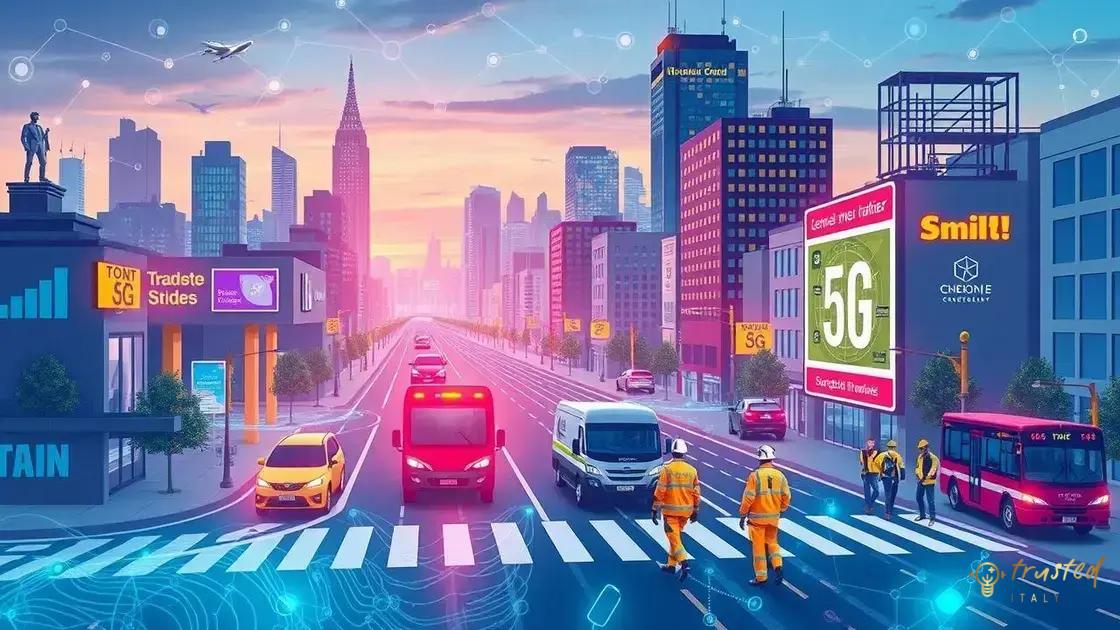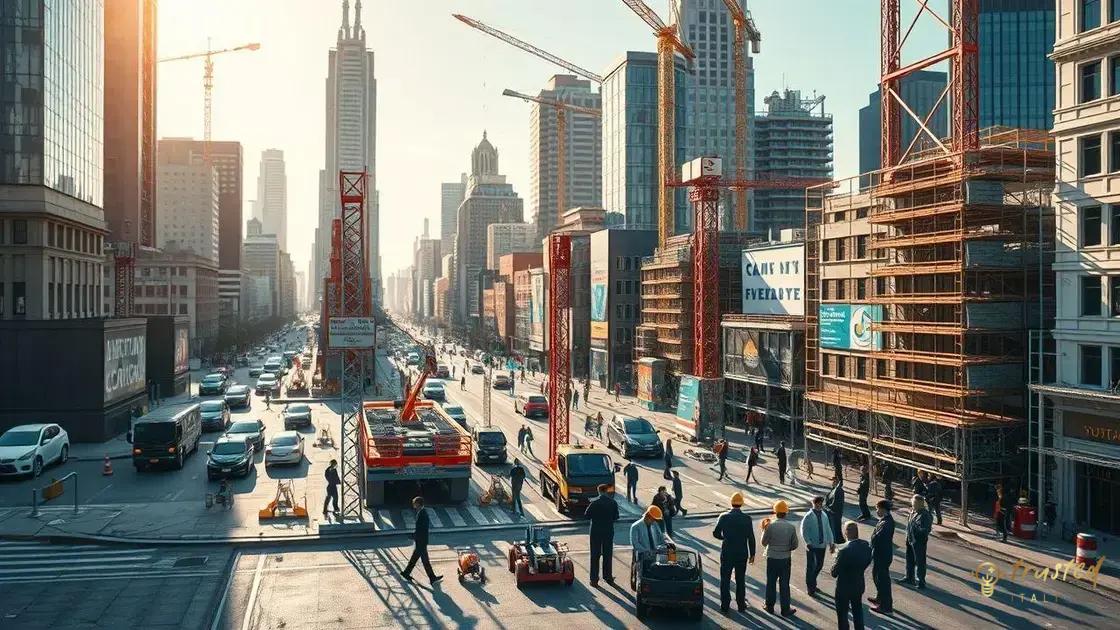The impact of 5G on the growth of smart cities

The impact of 5G on the growth of smart cities includes improved connectivity, enhanced public safety, efficient resource management, and the integration of AI and IoT, leading to better urban living standards.
The impact of 5G on the growth of smart cities is profound. With faster connectivity and enhanced communication, cities are becoming smarter and more efficient. Have you ever wondered how this technology will shape your urban life?
Understanding 5G technology
Understanding 5G technology is essential for grasping its role in shaping future smart cities. It represents the fifth generation of mobile network technology, significantly enhancing speed and connectivity. With download speeds up to 100 times faster than 4G, 5G not only enables seamless communication but also powers advanced IoT applications.
Key Features of 5G
5G introduces several key features that set it apart from previous generations:
- Low Latency: Communications happen in milliseconds, allowing real-time data transfer.
- Higher Capacity: 5G networks can handle more devices simultaneously, critical for densely populated cities.
- Enhanced Reliability: Built to provide stable connections even in crowded environments.
This technology relies on a network of small cell towers, enabling better coverage and reducing blind spots. For instance, urban areas filled with buildings will benefit from these strategically placed antennas to maintain connectivity.
How 5G Works
The architecture of 5G involves multiple frequencies, ranging from low to high bands. While low bands provide extensive coverage, high bands deliver faster speeds but over shorter distances. This combination allows cities to adapt to diverse needs, from rural areas to urban centers.
5G technology also employs advanced techniques like beamforming, which directs signals toward users rather than broadcasting signals in all directions. This approach not only boosts efficiency but also reduces interference, resulting in more reliable connections.
As we embrace this new wave of connectivity, understanding 5G technology becomes crucial for engaging with innovations that will transform our lives in smart cities.
Key benefits of 5G for smart cities

The key benefits of 5G for smart cities are transformative. This technology enhances connectivity, making urban living more efficient and enjoyable. With increased speed and capacity, it plays a vital role in addressing the challenges of modern urban life.
Improved Connectivity
One of the main advantages of 5G is its ability to connect more devices with enhanced reliability. As cities grow, the demand for a robust network increases. 5G meets this need by supporting vast numbers of connected devices simultaneously.
- Greater Internet of Things (IoT) Integration: 5G supports the growth of IoT devices, leading to smarter infrastructure.
- Faster Data Transfer: With speeds up to 10 Gbps, information sharing is instantaneous, enhancing applications like smart traffic lights.
- 24/7 Accessibility: Continuous connectivity enables real-time updates and services.
Another remarkable benefit is the ability to enable smart city applications. For example, energy management systems and public transport analytics are drastically improved with quick data analysis, leading to better resource allocation.
Enhanced Public Safety
5G also boosts public safety. It allows for real-time communication between emergency services, enhancing response times. When crises occur, faster data transmission ensures essential information flows quickly.
Moreover, 5G technology enables innovations such as smart surveillance systems. These systems can detect incidents faster and send alerts to authorities, increasing overall city security.
In summary, the key benefits of 5G for smart cities not only enhance connectivity and efficiency but also contribute to a safer urban environment, paving the way for future innovations.
Real-world examples of 5G applications
Real-world examples of 5G applications illustrate how this technology is influencing various aspects of daily life and urban infrastructure. Cities around the globe are harnessing the power of 5G to create smarter and more efficient environments.
Smart Transportation
One of the most notable applications is in the realm of transportation. 5G enables real-time data exchange between vehicles and infrastructure, leading to improved traffic management. For instance, cities like Los Angeles are implementing smart traffic lights that adjust signals based on current traffic conditions.
- Vehicle-to-Everything (V2X) Communication: This technology allows vehicles to communicate with each other and with traffic systems to prevent accidents.
- Autonomous Vehicles: Self-driving cars rely on rapid data transfer to navigate safely and efficiently in urban areas.
- Public Transit Tracking: Riders can receive real-time updates on bus and train schedules, making commutes more reliable.
Additionally, smart logistics in delivery services are being transformed by 5G. Companies like Amazon are optimizing their delivery routes with real-time data, ensuring packages arrive faster.
Healthcare Innovations
In the healthcare sector, 5G is revolutionizing patient care. Hospitals are integrating this technology to facilitate remote surgeries and telemedicine consultations. Surgeons can perform operations from miles away using robotic systems controlled in real-time.
Moreover, wearable devices connected through 5G can monitor patients’ health continuously. This ensures timely responses in emergencies and enhances overall healthcare outcomes.
Many cities are also utilizing 5G technology in surveillance and public safety. For example, smart cameras can analyze footage in real-time, enabling prompt action in critical situations.
These real-world examples showcase the immense potential of 5G applications across various sectors. They demonstrate not only how technology can improve daily life but also how it can contribute to the development of smarter cities.
Challenges in implementing 5G

Implementing 5G technology presents several challenges that cities and companies must navigate. While the benefits are vast, roadblocks exist that can slow down or hinder progress.
Infrastructure Costs
One of the main challenges is the high cost of building 5G infrastructure. Unlike previous generations, 5G requires a dense network of small cell towers. This density ensures reliable coverage in urban areas but comes with significant expenses for installation and maintenance.
- Site Acquisition: Finding locations for new towers in crowded cities can be difficult and time-consuming.
- Upgrading Existing Infrastructure: Many cities need to update current systems to support the new technology, adding to costs.
- Regulatory Hurdles: Navigating local regulations and obtaining permits can create delays.
Furthermore, some neighborhoods might resist the installation of new technology due to concerns over aesthetics or health effects. Public perception can greatly impact the speed of deployment.
Technical Challenges
Another significant challenge includes the technical requirements of 5G. This technology uses higher frequency bands, which can experience range limitations and signal degradation.
Moreover, the deployment of equipment that can handle the high speeds and low latency of 5G requires skilled personnel. There is a need for trained professionals who can manage and maintain this advanced technology effectively.
Finally, ensuring cybersecurity is critical. As cities become more interconnected, potential vulnerabilities increase, making it essential to develop robust security measures to protect infrastructure and data.
Despite these challenges, addressing them is crucial for realizing the potential of 5G and facilitating the growth of smart cities.
Future trends for smart cities with 5G
The future trends for smart cities with 5G technology are bright and full of possibilities. As cities continue to grow, the need for innovative solutions to enhance urban living becomes essential. 5G will play a pivotal role in shaping these urban environments.
Integration of Artificial Intelligence
One significant trend is the increasing integration of artificial intelligence (AI) with 5G networks. AI algorithms will analyze the massive amounts of data generated in smart cities. This will enable better decision-making and resource management across various sectors.
- Smart Traffic Management: AI can help optimize traffic flows by analyzing real-time data from vehicles and sensors.
- Enhanced Public Services: Incorporating AI in public services can lead to improved efficiency and responsiveness.
- Predictive Maintenance: AI can predict when infrastructure needs repairs before issues arise, saving cities money.
This fusion will lead to more responsive and adaptive urban environments that cater efficiently to citizens’ needs.
Expansion of the Internet of Things (IoT)
Another important trend is the expansion of the Internet of Things (IoT) within smart cities. With 5G’s low latency and high capacity, IoT devices can communicate seamlessly. This connectivity will allow for more sophisticated applications, such as:
- Smart Energy Management: Cities can optimize energy usage through connected smart grids.
- Environmental Monitoring: IoT devices can track air quality and pollution levels, helping to keep cities healthy.
- Connected Public Transportation: Riders will have real-time updates on their commutes, thanks to interconnected systems.
The ability to connect millions of devices simultaneously will foster more intelligent and efficient urban infrastructure.
As digital ecosystems evolve, cities will increasingly rely on 5G technology to enable seamless communication and improved services. This transformation impacts everything from waste management to public safety, leading to an overall better quality of life for residents.
The future of smart cities with 5G technology is not only promising but essential for creating better urban environments. As we have discussed, the integration of AI and the expansion of the Internet of Things will transform how cities operate. Overcoming challenges in implementing 5G will lead to a more connected and efficient urban infrastructure. With advancements in connectivity, the ability to respond to public needs becomes faster, leading to improved quality of life for city residents. Embracing these changes is crucial for creating sustainable, smart, and livable cities.
FAQ – Frequently Asked Questions about 5G and Smart Cities
What are the primary benefits of implementing 5G in smart cities?
The primary benefits include improved connectivity, enhanced public safety, efficient traffic management, and better resource allocation through real-time data analysis.
How does 5G support the Internet of Things (IoT)?
5G provides the necessary speed and low latency for millions of IoT devices to connect and communicate effectively, enabling smarter urban infrastructure.
What challenges do cities face when implementing 5G technology?
Cities face challenges such as high infrastructure costs, regulatory hurdles, and the need for skilled personnel to manage the technology.
What future trends can we expect in smart cities with 5G?
Future trends include deeper integration of AI, expansion of IoT applications, improved public services, and innovations in transportation and healthcare.